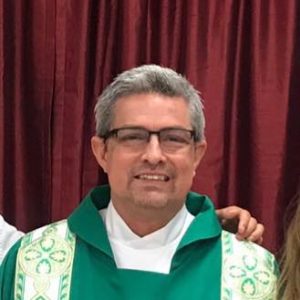By the time the monstrance carrying the Blessed Sacrament has completed the California leg of the National Eucharistic Pilgrimage’s Serra Route next week, it will have been carried across the Golden Gate Bridge, led a flotilla of boats down the Sacramento River, drawn people to adoration at a homeless shelter, and led another flotilla of boats across Lake Tahoe and into Nevada.
Just talking about it, Deacon Kevin Staszkow can hardly contain his excitement.

“This Eucharistic Revival is a historic thing for the Church in the United States, and it needs to be marked by something epic,” says Staszkow, the lead planner for the pilgrimage’s 4-day segment in the Diocese of Sacramento.
Beginning in Northern California and Nevada before proceeding north to Oregon and Idaho and then east, the Serra Route is one of four national itineraries established to bring Catholic pilgrims — led by the Blessed Sacrament — to Indianapolis, the site of the National Eucharistic Congress July 17-21.
Organizers like Staszkow are determined to make the most of it.
It was the deacon’s boss, Bishop Jaime Soto of Sacramento, who first had the idea of moving parts of the route from land to water. So from May 21 to 22, Soto will accompany the Blessed Sacrament aboard a 64-foot boat (borrowed from a Catholic benefactor) with a flotilla following in possession, making several stops along the Sacramento River.
After all, Staszkow explains, the river itself was named after the Blessed Sacrament, as was the city.
“It really doesn't make sense to do anything except have the Eucharist travel on the Sacramento River,” said Staszkow, who heads the Diocese of Sacramento’s young adult ministry and faith formation offices. He remembers that the plan was first met with skepticism.
“Everybody said, oh, you're not going to be able to get a boat,” Staszkow said. “But I got a boat.”
Before the Sacramento portion, the pilgrimage will kick off in San Francisco with a May 19 bilingual Pentecost Sunday Mass at the Cathedral of St. Mary of the Assumption celebrated by Archbishop Salvatore Cordileone. Immediately after, Cordileone and hundreds — perhaps thousands — of Catholics will process through the city’s streets with the Blessed Sacrament.

After a break to eat and rest, the procession will continue across the Golden Gate Bridge. Coincidentally, the iconic bridge was already scheduled to be closed earlier that day for the city’s annual “Bay to Breakers” footrace.
Having crossed the bridge, Cordileone will lead pilgrims in Benediction at Point Cavallo, a lookout point with views of the San Francisco Bay. The pilgrimage will continue through Marin County, including Mission San Rafael Arcángel, before moving on to the Diocese of Sacramento.
While the procession will make for a visual spectacle, Cordileone says the pilgrimage’s kickoff is not about a photo op.
“It’s a public manifestation of faith,” Cordileone told Angelus. “That’s what processions are, and this is a very powerful one because it's encompassing the whole country. Our faith is not meant to be kept within the walls of the churches, but to be brought out into the public square.”
As it heads east across Northern California, the pilgrimage will make stops Bishop Soto hopes will connect with different “marginalized populations,” including a Mass with farm workers in Vallejo, a walking procession leaving from Folsom State Prison, and a visit to Sacramento homeless shelter Loaves and Fishes.

The route’s California portion ends on Friday, May 24, when Soto will again accompany the Blessed Sacrament leading a flotilla of boats, this time crossing Lake Tahoe at sunset (approximately a 26 mile journey) before arriving at Incline Village, Nevada, for a Eucharistic “handoff” to the neighboring Diocese of Reno.
Sister Maria, a woman religious from the Archdiocese of Los Angeles, plans to travel the Serra Route as a pilgrim by car from San Francisco to Indianapolis. She is making the pilgrimage out of gratitude to the Eucharist for bringing her to the church when she was in her twenties, but also as an opportunity to pray for others’ intentions (she’ll carry a prayer book for people to write them in) and in reparation for the lack of belief in the Eucharist she sees firsthand.
“[Many Catholics] don’t believe in Jesus and the Eucharist anymore, and that is the whole point of this Eucharistic Revival, to draw people back to Mass and love of Jesus and the Eucharist,” said Sister Maria, who asked to remain anonymous.
As it makes its way through parts of the western U.S., Archbishop Cordileone hopes the pilgrimage will “reignite an authentic Eucharistic faith” among Catholics.
“I hope it instills in our Catholic people a reminder of the sacredness of what the Eucharist is, and who it is,” said Cordileone.
Crossing the country over the course of two months, Sister Maria plans to be hosted in some places by friends or in convents with other women religious. In others, she’ll have to leave it to Providence.
“You make your plan, but God always changes it,” said the sister, who works in youth ministry at a parish in the LA Archdiocese. “But at least you do your part and then you see what unfolds.”

